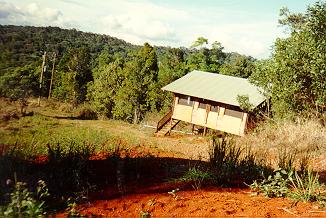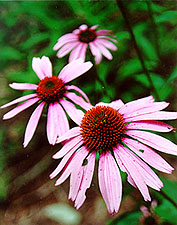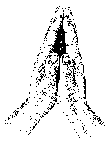
Science as Compassion
By Wendee Holtcamp
*
Just a year from high school graduation, I still had no clue what I
wanted to do with my life. As a senior, Itook a Marine Biology elective that opened
my eyes to the world of science, nature, and wildlife. In the first few weeks, we took a field trip toTexas' Galveston Bay to collect ocean waterand
sea critters. Each student, myself included, maintained their own salt water tank all year that was filled with sea anemones, fish, sea urchins and other
creatures we had collected from the Bay.
During the semester, I learned to identify creatures ranging from sea stars to octopi, from salmon to sea lions. The course merged chemical and physicaloceanography with marine biology and ecology. I loved the class so much that my grades were consistently high A's.
Partially because of that marine bio class, I decided to major in biology/pre-med in college. During my junior year,
I flew to Australia to take classes in the rainforest -- on a School for Field Studies Rainforest Ecology
semester abroad. With twenty other  students, we lived, breathed, and studied
tropical rainforests for three months.Living in remote cabins, we awoke at dawn to identify colorful birds, swam in ancient crater lakes, had daytime
lectures in the forest, and learned all aboutthe unique Australian animals and plants.
students, we lived, breathed, and studied
tropical rainforests for three months.Living in remote cabins, we awoke at dawn to identify colorful birds, swam in ancient crater lakes, had daytime
lectures in the forest, and learned all aboutthe unique Australian animals and plants.
Each student designed and conducted a science experiment. My project -- done with two others students -- looked at whether an old logging road that "fragmented" the rainforest into two sections affected the nightly movements of rainforest small mammals. It turned out that the logging road did inhibit mammal movements, but more importantly I discovered that I loved science!
I enjoyed getting up at 5am to venture into the dark rainforest, checking each live trap to see if we had caught something, and listening to the vibrant rainforest sounds as the sun rose. I loved analyzing the data we had collected to see if the logging road impacted these native animals, and I enjoyed working with other students and presenting our findingsto others.
Although I didn't realize it at the time, my science experiences were life-transforming spiritual experiences that brought me closer to knowing Jesus Christ. I experienced God's Creation in an intimate way by studying it, and byliving remotely -- in sync with the natural world.
Many scientists and explorers of the historic past studied science to learnmore about the mind of God. Their scientific writings were intertwined with their belief in God. From Galileo to Newton to Linnaeus, many scientists chosetheir vocation as a way to more fully understand and appreciate the Creator.

During the seventeenth century, the idea of "natural theology"arose among scientists. This meant that the wisdom and power of God could be partially understood by studying God's Creation. Seventeenth century naturalist John Ray searched for a way to classify living organisms that would reflect the Divine Order of creation. Ray was an Anglican priest and a strong believer innatural theology.
In 1660 Ray wrote, "There is for a free man no occupation more worthy and delightful than to contemplate the beauteous works of nature and honour theinfinite wisdom and goodness of God." Ray's beliefs were a breakthroughfrom medieval times, when Christian theologians shunned the natural world,believing that it distracted people from salvation.
A compassionate way to follow Jesus
As technology became more advanced during the 20th century, thefield of science expanded greatly. You might be surprised to learn that themajority of scientists who have ever lived are still alive today! As technologycontinues to improve, scientists probe deeper into the realms of chemistry,physics, biology, geology, anthropology, psychology, and technology development.
More than simply learning more about the created order, scientists actually serve humanity through science -- an exciting way to follow Jesus' example.Jesus had compassion on people in need. He healed the sick, gave sight to the blind, raised the dead, and taught about God's wisdom and love.
Like Jesus, we too can heal, reverse death, open eyes, and serve God and humankind through scientific endeavors. We can search for disease cures, or waysto improve lives of the sick or less fortunate. We can investigate more efficient agricultural methods to help impoverished peoples. We can identifyways to preserve wild creatures for future generations. We can teach others in the ways and means of science.
Without people dedicating their life's work to science, today we might nothave the vaccines for polio, smallpox and
other deadly diseases. Withoutecologists studying environmental problems, we might not have passed laws outlawing the toxic chemical DDT or protectingour air and water resources.
we might not have passed laws outlawing the toxic chemical DDT or protectingour air and water resources.
The 21st century offers both unique and age-old challenges.Although disease has plagued humanity since Adam and Eve were expelled from theGarden of Eden, rapid advances in science and technology make finding cures moreplausible than ever before. And though people have roamed the earth since Eden,our collective impact has exponentially increased in the past few centuries. Thehuman population has exploded, wild places have disappeared, and millions ofacres of what once was "Creation" now lie under concrete and asphalt,freeways and cities.
Science and technology can help solve the problems we currently face if usedwisely. Gene therapy, cloning, and bioengineering offer virtually unexploredpossibilities for helping humanity and Creation in the new millennium. Buttechnology doesn't provide foolproof answers. We must make sure our knowledge and technology doesn't surpass our ability to thoughtfully and carefully apply it.
Humankind has a history of "trying things out" before thoroughly– or prayerfully -- analyzing the possible
impacts. In Old Testament times,people tried to build a tower to the heavens to "make a name" forthemselves (Gen. 11:1-9). The Tower of Babel
account reflects the need toproceed cautiously with technology. Christians in science can become aninfluential force in helping citizens and fellow
scientists realize the need fordiscretion and humility when using and applying technology, even when it's for agood cause.
Blessed are the
peacemakers
Perhaps science seems like a difficult field of study. But Albert Einstein called science, "simply a refinement of everyday thinking."When we engage in science, we probe the mind of God.
Everything scientistsstudy, God Almighty created. We can humbly search for wisdom and knowledge by learning about the workings of the vast universe.
Although science and religionhave had historical and current conflict, the two are complementary.
Einstein called science, "simply a refinement of everyday thinking."When we engage in science, we probe the mind of God.
Everything scientistsstudy, God Almighty created. We can humbly search for wisdom and knowledge by learning about the workings of the vast universe.
Although science and religionhave had historical and current conflict, the two are complementary.
Einstein also said, "Science without religion is lame. Religion without science is blind." Recently Pope John Paul II elaborated on this same point, "Science can purify religion from error and superstition; religion can purify science from idolatry and false absolutes. Each can draw the other into a wider world, a world in which both can flourish."
Walter Hearn, author of the book Being a Christian in Science says, "It's wrong to think of most scientists as trying to do away withGod, or to establish some grand philosophical truth." Hearn is a retired research biochemist and a dedicated Christian.
The scientific method was designed as a neutral, non-biased way to study the world without allowing personal opinions to creep into the results. Because of its very nature, when science is performed accurately, the results simply reflect reality.
"Most of the time scientists focus on trying to solve an immediate problem, like a detective unraveling a murder case," explains Hearn."They try to think of all the possible solutions and then try experimenting to eliminate all that don't match the clues."
The Christian attributes of faith, hope, and love can be a terrific gift to a research group, Hearn says. Christians can also bring their values of honesty, humility, and compassion to their scientific endeavors. Followers of Jesus can help bring peace and understanding between science and religion.
research group, Hearn says. Christians can also bring their values of honesty, humility, and compassion to their scientific endeavors. Followers of Jesus can help bring peace and understanding between science and religion.
"If you enjoy science, God might well call you to be one of the bridges in the twenty-first century that allows Christians and scientists to understand one another," says Rich Milne of Probe Ministries in his review of Hearn's book. "It is a critically important calling."
A few weeks after I returned to the U.S. from "down under," I met the man who is now my husband, Matthew, who re-introduced me to Jesus Christ. Matt was about to start his Ph.D. in chemistry, getting an education in a field he found creative and challenging. I changed my major from pre-med to wildlife ecology as a result of my Australian rainforest experience.
After graduating from college, I decided to also earn an M.S. degree in Wildlife Ecology. I learned about evolutionary theory, ecosystem dynamics, and animal behavior. I humbly joined the ranks of scientists who have been inspired by God's Creation enough to study a small part of it. And it is my prayer that through teaching and writing about science, I might inspire others interest topursue this important and compassionate vocation.
WendeeHoltcamp teaches biology at Kingwood College in Texas and is a freelancescience/environment writer and photographer. Her work has been published in DiscoveryChannel Online, Audubon Magazine, ScienceNow, Texas Parks & Wildlife, andothers. She attends a Lutheran church with her husband and two young children.She also paints, writes poetry, and teaches bible study. Visit her web site at http://www.greendzn.com.
Links to Science, Nature, and Faith web sites
Evangelical Environmental Network (EEN): A Ministry of Evangelicals forS ocial Action
http://creationcare.org/
Earth Ministry: 'Connecting People with the Creation'
http://www.earthministry.org
A Rocha: Christians in Conservation
http://www.arocha.org
Target Earth: Serving the Earth, Serving the Poor
http://www.targetearth.org
Au Sable Institute of Environmental Studies: Serving and promoting Christian earthkeeping on 3 continents
http://www.ausable.org
Text and Photographs Copyright (c) 2000 Wendee Holtcamp